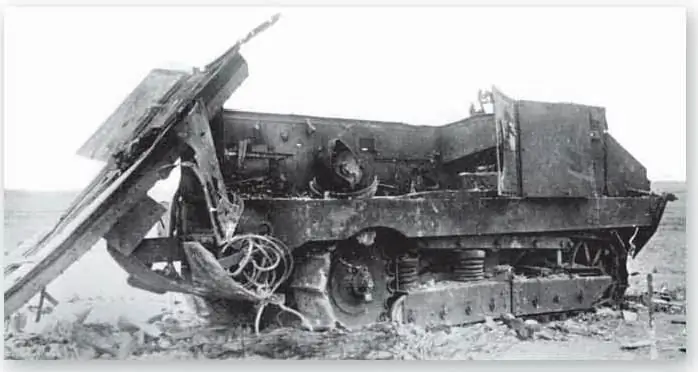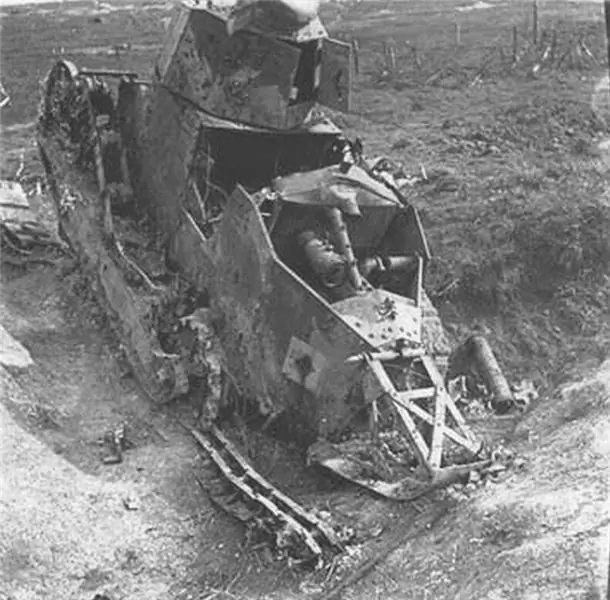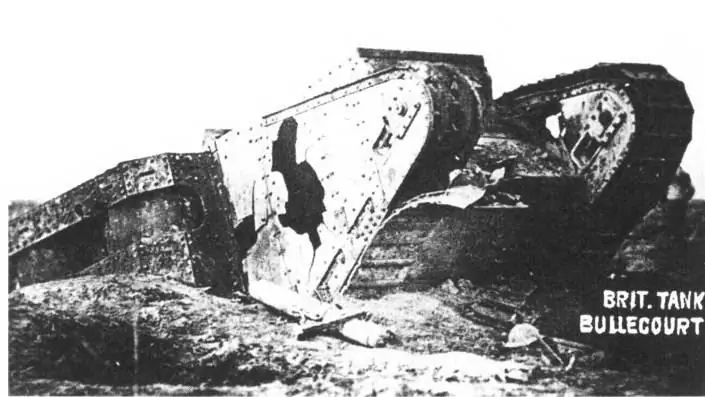- Author Matthew Elmers [email protected].
- Public 2023-12-16 21:49.
- Last modified 2025-01-24 09:17.
What were the Allied tank losses on the French front in World War I? This article is devoted to the topic of losses in offensive battles from German artillery fire from tanks of the main tank powers of the world war, Great Britain and France, in the light of the experience of the First World War. It analyzes the features of tank losses and indicates the numbers of total and irrecoverable losses in the tank units of the allies.
The tanks were first used in the Battle of the Somme in 1916.
Campaigns 1917-1918 on the French front - this is the triumph of the tank.
The tank made it possible to effectively break through the enemy's tactical defenses, minimizing infantry losses. But never a tank tactical breakthrough during the World War was transformed into an operational breakthrough. The Germans learned how to deal with the tank factor - for example, in the battle of Cambrai, German assault units with an effective counterattack not only eliminated the consequences of a tank attack, but also achieved impressive tactical successes.
At the end of World War I, tanks had a significant impact on the course and outcome of a number of major battles - especially at Cambrai in November 1917 and at Soissons and Amiens in July and August 1918.
In the battle of Cambrai, the British, quite unexpectedly for the enemy, brought 378 tanks into battle and, having lost less than 4 thousand men and 100 tanks, achieved the same tactical successes (advancing 13 km along the front and 9 km deep into the German defense), as well as for the four-month battle in Flanders (June - November 1917), where their losses reached 400 thousand people.
The overwhelming majority of losses in tanks during World War II were borne by the allies from enemy artillery fire.

Fig. 1. French infantry tank SA-1 Schneider - a victim of a direct hit from a German shell. The hit of the shell in the fuel tank led to the death of the tank along with the crew. Photo: Steven J. Zaloga. French tanks of World War I. - London, 2010.
The most terrible enemy of tank armor was the armor-piercing projectile (they were equipped with the first anti-tank guns, they formed part of the ammunition in the arsenal of field guns used for anti-tank defense). Such a projectile, which has the corresponding hardness of the hull, striking the armor of the tank, will not split, but, retaining its striking force, will pierce the armor and explode inside the tank. If an AP shell explodes when it hits the armor, its effect will be insignificant. Accordingly, the fuse mechanism must not only be strong, but also act with deceleration.
The armor penetration of the first anti-tank guns was such that at a firing distance of 1,000 m, a 20-mm gun, at an angle of encounter between a projectile and an armor of 90 °, penetrated 20-mm armor, and a 57-mm gun - 45-mm armor.
When the angle of encounter between the projectile and the armor is less than 45-30 °, the projectile will slide over the surface of the tank's armor. When the projectile hits the armor, the degree of sharpening of the projectile's head is also important.
Considering that anti-tank artillery was only in its infancy, the main brunt of the fight against tanks fell on the field artillery guns.
A direct hit from a high-explosive shell from a field gun was also fatal to the tank. But the effect of fragments of a high-explosive projectile on the armor of a tank is much weaker than the effect of an armor-piercing projectile. For example, a 75-mm high-explosive projectile with a projectile weight of 6, 5 kg and an explosive charge weight of about 0.6 kg could penetrate armor up to 20 mm thick with its fragments, and a 105-mm projectile with an explosive charge weight of up to 1.6 kg could penetrate shrapnel weighing about 50 g each armor thickness up to 25 mm. But this is provided that the shell bursts in the immediate vicinity of the tank and at an angle of encounter between the fragment and the armor of 80 - 90 °. The tremendous speed of shell fragments near the point of explosion decreases very quickly as they move away from this point, and already at a distance of more than 15 meters, the fragments of a high-explosive projectile cannot penetrate the tank's armor. That is why, if anti-tank guns worked point-wise against tanks, then the density of its fire was of paramount importance for firing field artillery.
A field artillery division could place an anti-tank barrage in a combat area 300 m wide. On an area of this width, no more than 10 - 15 tanks can be at the same time, but if we take into account the separation in depth, then no more than a battalion of tanks can move in such a strip. The zone of continuous defeat for a high-explosive projectile, depending on the caliber, was as follows: 76 mm - 40 m, 107 mm - 84 m, 122 mm - 144 m, 152 mm - 264 m.
Thus, in order to disable a tank during the First World War with the help of field artillery fire, either a direct hit of a high-explosive projectile into the tank or a burst of a projectile in its immediate vicinity was necessary.

Fig. 2. Burned French Renault FT light tank. Photo: New York Public Library.
The magnitude of tank losses during an offensive directly depended on their speed of movement at the moment of approaching the front edge of the enemy's defense and on the presence of engineering structures that could narrow the front of a tank attack. Artillery fire on advancing tanks, as a rule, was opened from a distance of about 1500 m, and at a distance of 500 - 700 m it was most effective.
The losses of French tanks in the battle of Soissons were as follows:
- On July 18, 1918, out of 342 attacking tanks, 102 were lost (including 62 - from artillery fire) - 30% of the grouping;
- On July 19, 1918, out of 105 attacking tanks, 50 were lost (all from artillery fire) - 47, 6% of the grouping;
- On July 20, 1918, out of 32 attacking tanks, 17 were lost (all from artillery fire) - 53, 1% of the grouping;
- On July 21, 1918, out of 100 attacking tanks, 32 were lost (all from artillery fire) - 32% of the grouping;
- On July 23, 1918, out of 82 attacking tanks, 48 were lost (all from artillery fire) - 58, 6% of the grouping.
Thus, the Soissons battle cost the French 249 tanks (out of 661 participating in the operation), and 209 of them were victims of artillery fire. Losses amounted to 37.6% of the grouping.
In the battle of Amiens in August 1918, the British lost 169 out of 415 tanks put into battle - that is, 40% of the grouping.

Fig. 3. British tank MK II destroyed by artillery fire. German photo. David Flether. The British tanks 1915-19. - Crowood Press, 2001.
Thus, the total losses of allied tank groupings on the French front during the First World War during the offensive amounted to up to 40% of their combat strength. Of course, these 40% of the tanks that were out of action were not irretrievably lost: most of them returned to service after restoration. The irrecoverable loss of tanks was: 7.2% for the French tank units and 6.2% in the British tank corps.






